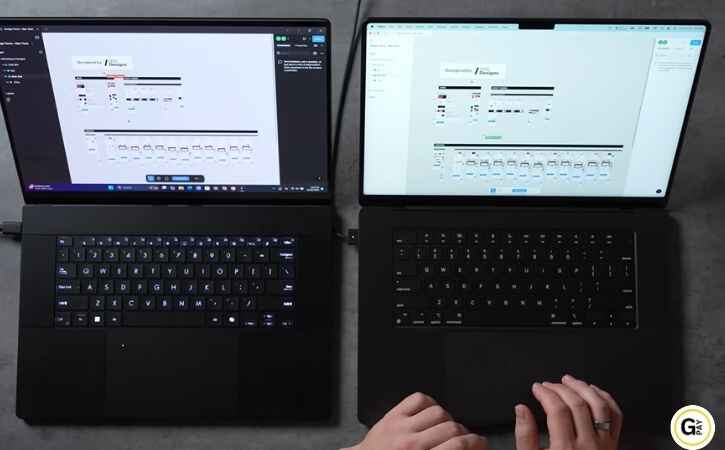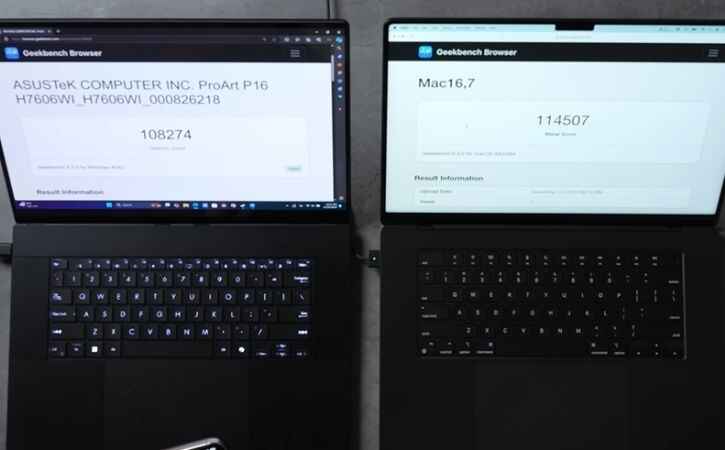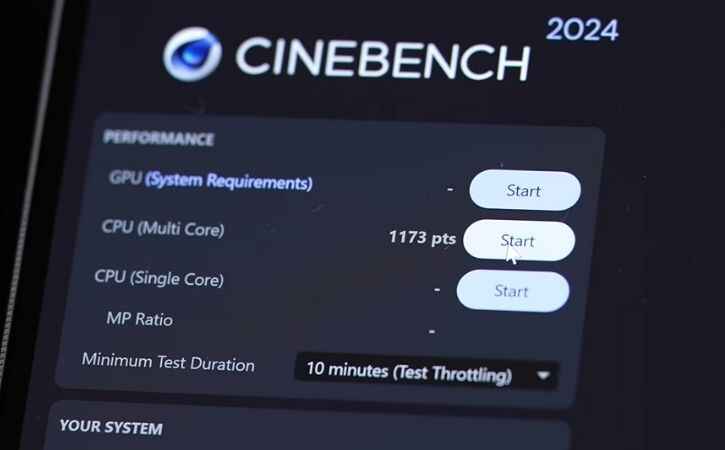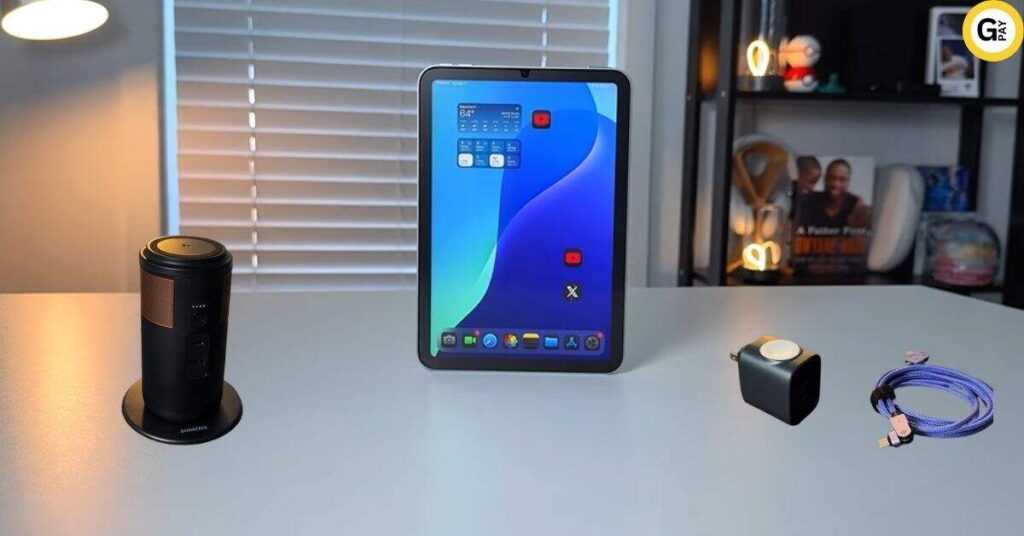M4 Pro vs AMD HX 370 Laptop 16-in M4 Pro MacBook Pro versus 16-in Windows laptop, which one is the better pick? Well, in this post, I have the Asus Pro Art 16, which is my favorite thinner, light 16-in Windows laptop, of course, versus the M4 Pro.
Spec List & Prices
The specs: the M4 Pro is actually a little bit cheaper, $2,500 versus $2,700. That’s because it has a 512GB SSD, so if you actually match the 2TB, you’d be at $3,100. Of course, we know Apple overcharges on their storage.
In terms of the chips, this is the upgraded 14-core CPU and 20-core GPU version of the M4 Pro versus the AMD HX 370, which is an awesome chip for thin and light laptops with an RTX 470 laptop GPU.
Ports Compared

Storage speed test, and while this is running, I do want to mention the difference in ports. The Asus laptop does have a couple of USB A’s with two USB C’s, one of them being USB 4 with 40 GB per second speeds. They both have HDMI and SD cards, but the big upgrade on the M4 Pro MacBook Pro is that it now has three Thunderbolt 5 ports, which is awesome.
SSD Storage Speed Test

Storage right here, and you can see that the M4 Pro actually has a faster speed in terms of read speed: 5900 compared to 5200. In terms of write speed, the Asus is a little bit faster: 4,900 compared to 4,400.
Geekbench 6 CPU Test

Have Geekbench 6 open right here, and you can see that the M4 Pro now comes with 24 gigs of RAM at the base price. The Asus comes with 64, which is absolutely nuts. So let’s actually see how that’s going to translate into real-world performance with this test and, of course, a lot of the other tests we’re going to do in this article.
All right, we got our results in—holy smokes, this time Apple is going crazy. The single-core score is almost 4,000—42% faster than what we have on this HX 370 AMD chip. But in terms of multicore, the difference is even bigger: 52% faster on this M4 Pro chip than the Asus. That is insane.
Web Browsing Performance
Speedometer 3.0, which is basically a web browsing speed test, kind of measures how snappy both systems are for web-based apps, and here we have a massive difference: 69% faster web browsing on the M4 Pro because, of course, that’s based on single-core performance.
Figma Web Design
Figma, which is for web design, is a project provided to us by 500 Designs, one of the best-designed studios based out of California, one of the things we do here is zoom in and see kind of how fast the stuff loads.
I mean, look at that; I mean, it was instantly sharp as soon as I zoomed in on the M4 Pro. Let’s do it here. Okay, is that loaded? I can’t tell either; it’s a little bit alias, but hey, that was also seemingly nice and quick.
But the main test we run here is exporting 12 high-quality layers in terms of 4X PNGs to see which one finishes faster, and we time it. So let’s do it on the Asus first.
The crazy thing is that the fans are running on the Asus laptop while doing web design, and there you go, it’s finished on both, and the M4 Pro finished in a minute and 9 seconds compared to a minute and 20 on the Asus laptop, so 11 seconds faster for the new M4 Pro.
Geekbench 6 Metal


Some graphics, we have Geekbench 6. We’re going to be running the OpenCL test on this laptop. It has an RTX 470 laptop GPU compared to the 20-core M4 Pro running Metal.
The founder and creator of Geekbench did say that both OpenCL and Metal are designed to be cross-compatible in terms of the scoring systems, just Metal is optimized for Mac and OpenCL for Windows.
And holy smokes, guys, for the first time in years, the M4 Pro outperforms the RTX 470 laptop in terms of RAW graphics performance in Geekbench, 5.7% faster—can you believe it?
This is plugged in, so let me actually unplug both of these laptops and run it again. And here you can see the performance of the RTX 470 went down a little bit on battery power. It’s pretty impressive, while the Mac stayed the same on battery. I’ve plugged them both.
3DMark Steel Nomad Light
To make it fair for the Asus laptop, now we have 3DMark Steel Nomad Light, which is their most recent and most modernized AAA gaming benchmark. So this should show us the difference in performance for modern gaming with the game being optimized for both of these systems.
3DMark & Gaming Tests
In 3DMark Steel Nomad Light, the Asus laptop outperformed the M4 Pro by 54% higher FPS. Similarly, for ray tracing tests like Solar Bay, the RTX 470 was 56% faster.
Blender 3D Rendering
For rendering, the RTX 470 finished in 27 seconds compared to the M4 Pro’s 47 seconds, solidifying Nvidia’s dominance in 3D tasks.
Thermal Throttling Test
After a 10-minute stress test:
- Asus hotspot: 40°C.
- M4 Pro hotspot: 35°C.
- The M4 Pro remained cooler under load and achieved 50% higher multi-core scores.
Lightroom Classic Photo Editing
The M4 Pro was a clear winner:
- Exported 50 RAW photos in 22 seconds compared to 57.85 seconds on the Asus.
- On a 500-photo export, it finished in 4:47 versus 9:13 on the Asus.
DaVinci Resolve Video Editing
- In 6K BRAW exports, the M4 Pro finished in 15 seconds, compared to 32 seconds for the Asus.
- For general 4K HEVC exports, the Asus was slightly faster by 8 seconds.
Conclusion: Which Laptop to Buy in 2024?
If your focus is photo editing, video editing, or general productivity, the MacBook Pro with its M4 Pro chip is the clear winner. It dominates in:
- Web browsing and design.
- Port selection (Thunderbolt 5).
- Resale value.
- Thermal management.
- However, if you prioritize gaming or 3D rendering, the Asus ProArt P16 with its RTX 470 GPU takes the lead.
Recommendation: Unless your focus is gaming or 3D rendering, MacBook Pro all the way — though be mindful of Apple’s high storage and RAM upgrade costs.













